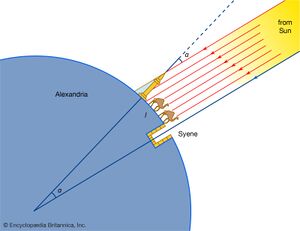Difference between revisions of "Eratosthenes"
Tom Bishop (talk | contribs) |
Tom Bishop (talk | contribs) |
||
| Line 23: | Line 23: | ||
===Agreement With Modern Value=== | ===Agreement With Modern Value=== | ||
| − | It is often claimed that Erasthonese's circumference agrees with the modern value for the circumference of the Earth, and that this is evidence in favor of the globe. However, it should be noted that the 'modern value' is based on a repetition of the original experiment | + | It is often claimed that Erasthonese's circumference agrees with the modern value for the circumference of the Earth, and that this is evidence in favor of the globe. However, it should be noted that the 'modern value' is based on a repetition of the original experiment made with the same assumptions, with updated methods for accuracy: |
https://www.britannica.com/topic/Measuring-the-Earth-Modernized-1673316 | https://www.britannica.com/topic/Measuring-the-Earth-Modernized-1673316 | ||
Revision as of 22:05, 31 August 2021
Eratosthenes, or Eratosthenes of Cyrene, (c. 276 BCE - c. 194 BCE), was a Greek scientific writer, astronomer, and poet, who was reputed for making the first measurement of the size and circumference of Earth. Although his original manuscripts were lost, a version described by Cleomedes was used[1] to popularize the measurement.
Round Earth Circumference Experiment
Erasthonese measured the angle of the Sun from two North-South points separated by a distance of 500 miles, Syene and Alexandria. While the sun was directly overhead at one location, it was angled at 7°12' south of zenith at the other city. This allowed him to compute the circumference of the Earth under the assumption that it was round, the sun was distant, and that the displacement of the sun at the second location was due to the observer standing at different angle upon the curved Earth.
https://www.britannica.com/biography/Eratosthenes
Eratosthenes' method of measuring Earth's circumference
“ By knowing the length of an arc (l) and the size of the corresponding central angle (α) that it subtends, one can obtain the radius of the sphere from the relation that the proportion of the length of arc l to Earth's circumference, 2πR (where R is Earth's radius) equals the proportion of the central angle α to the angle subtended by the whole circumference (360°)—i.e., l : 2πR = α : 360. ”
Assumptions
Millersville University explains that Eratosthenes assumed that the earth was a sphere, the sun was very far away, and that light traveled in straight lines.
https://www.millersville.edu/physics/experiments/058/index.php
“ Eratosthenes analyzed the observations with the assumption that the earth is a sphere and the sun is very far away. ”
“ Because the sun is assumed to be very far away, we believe that the light rays which reach us from the sun are all going in the same direction; they are parallel. ”
Agreement With Modern Value
It is often claimed that Erasthonese's circumference agrees with the modern value for the circumference of the Earth, and that this is evidence in favor of the globe. However, it should be noted that the 'modern value' is based on a repetition of the original experiment made with the same assumptions, with updated methods for accuracy:
https://www.britannica.com/topic/Measuring-the-Earth-Modernized-1673316
Measuring the Earth Modernized
“ In its modern form, the method requires the following elements: two stations on the same meridian of longitude, which play the same parts as Aswan and Alexandria in the method of Eratosthenes of Cyrene (c. 276–c. 194 BC); a precise determination of the angular height of a designated star at the same time from the two stations; and two perfectly level and accurately measured baselines a few kilometres long near each station. What was new 2,000 years after Eratosthenes was the accuracy of the stellar positions and the measured distance between the stations, accomplished through the use of the baselines. ”
Flat Earth Interpretation
Displacement of the Sun
Under the Flat Earth Theory the cause of the displacement of the sun in the sky at two different locations is often attributed to either Electromagnetic Acceleration or a perspective theory. See: Sunrise and Sunset
Monopole Model Interpretation
It's a common misconception that Eratosthenes was measuring the circumference of the round earth in his shadow experiment. Eratosthenes had simply assumed that the earth was a sphere in his experiment, based on the work of Aristotle. He was actually measuring the diameter of the flat earth (distance across), which is a figure identical to the circumference of the round earth (distance around).
We can use Eratosthenes' shadow experiment to determine the diameter of the Flat Earth Monopole Model.
Syene and Alexandria are two North-South points with a distance of 500 miles. Eratosthenes discovered through the shadow experiment that while the sun was exactly overhead of one city, it was 7°12' south of zenith at the other city.
7°12' makes a sweep of 1/25th of the FE's total longitude from 90°N to 90°S (radius).
Therefore we can take the distance of 500 miles, multiply by 25, and find that the radius of the flat earth is about 12,250 miles. Doubling that figure for the diameter we get a figure of 25,000 miles.
The earth is physically much larger, of course. A circle with a diameter of 25,000 miles across is simply the area of land which the light of the sun affects, and represents the area of our known world.
Footnotes
1 A University of Puget Sound paper titled The Two Earths of Eratosthenes describes that Eratosthenes’ original work was lost and summarized centuries later:
“ Although Eratosthenes’ account of his measurement of the circumference of the Earth has not survived, some centuries later Cleomedes summarized it in a reasonably detailed report.6 ”


